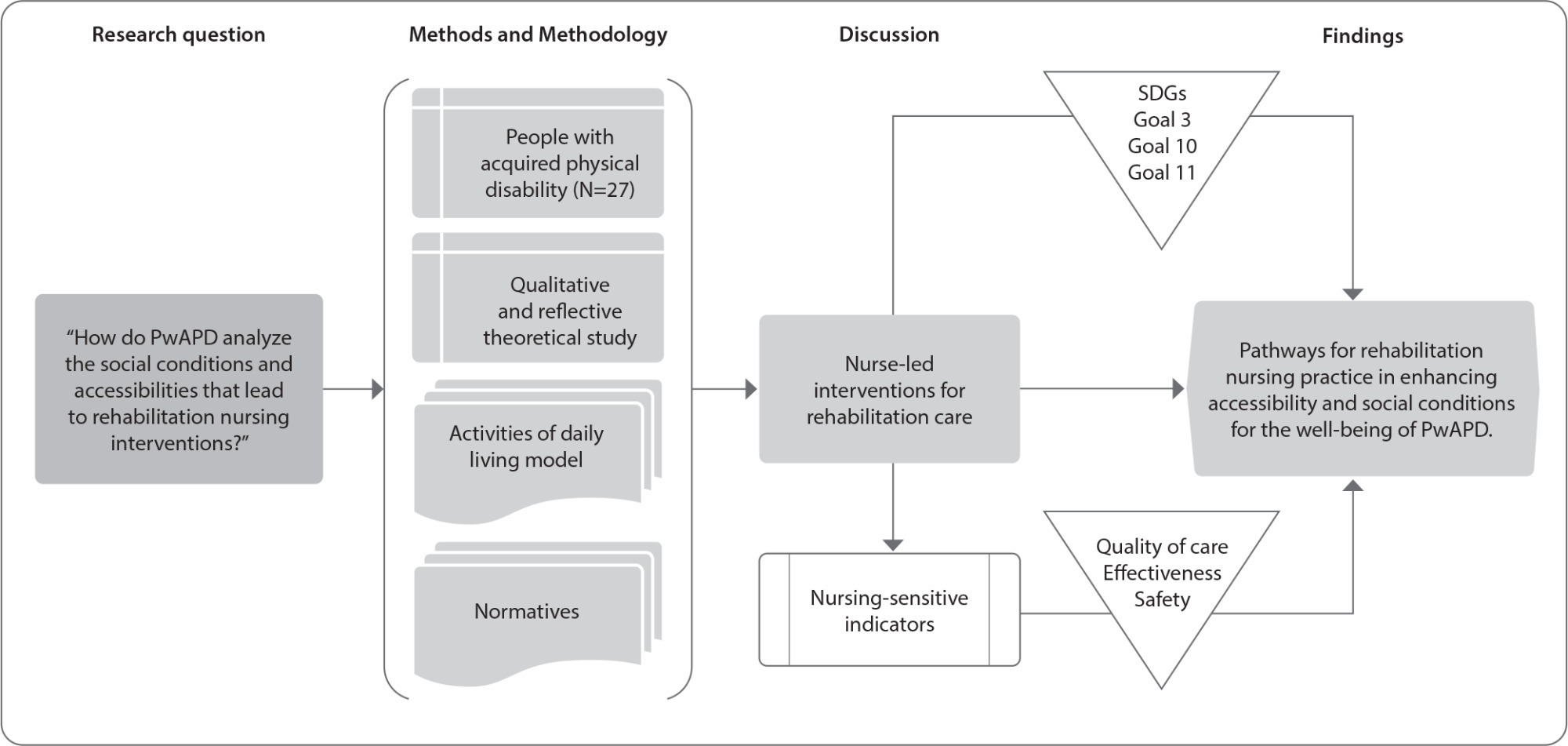-
ORIGINAL ARTICLE12-08-2024
Initial nipple damages in breastfeeding women: analysis of photographic images and clinical associations
Revista Brasileira de Enfermagem. 2024;77(1):e20220773
Abstract
ORIGINAL ARTICLEInitial nipple damages in breastfeeding women: analysis of photographic images and clinical associations
Revista Brasileira de Enfermagem. 2024;77(1):e20220773
DOI 10.1590/0034-7167-2022-0773
Views0See moreABSTRACT
Objective:
to analyze the initial nipple damage degree by breastfeeding practice and to associate findings with clinical manifestations of breastfeeding women.
Methods:
a retrospective, cross-sectional study with primary data and photographic images database from two randomized clinical trials. Photographic images were analyzed by two independent evaluators using the Nipple Trauma Score. For analysis, the chi-square, Mann-Whitney tests and Kappa coefficient were applied.
Results:
115 breastfeeding women and their respective 186 photographic images were analyzed. The degree of agreement of evaluators using the Nipple Trauma Score was 93.6%. The nipple pain score during breastfeeding was moderate and compromised more than 25% of the nipple surface area.
Conclusions:
assistance to breastfeeding women should prioritize nipple pain intensity instead of the nipple damage size.
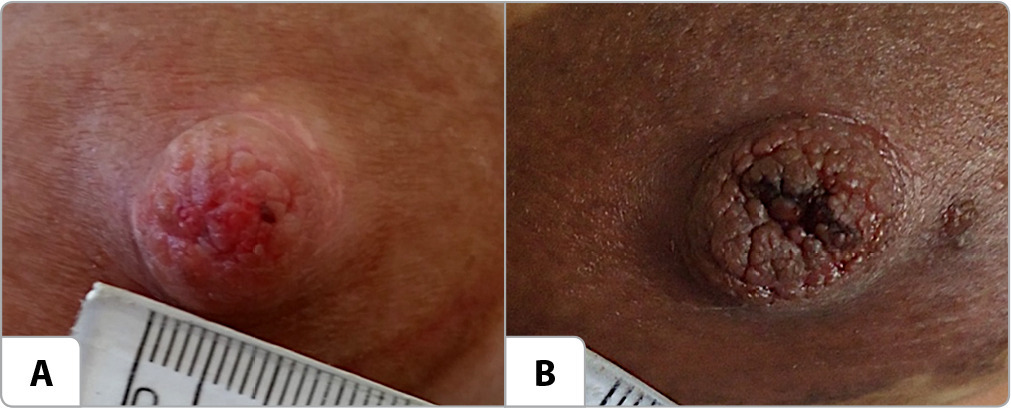
-
ORIGINAL ARTICLE12-08-2024
Safe practices for bed bathing in the intensive care unit: validation of a checklist
Revista Brasileira de Enfermagem. 2024;77(1):e20230135
Abstract
ORIGINAL ARTICLESafe practices for bed bathing in the intensive care unit: validation of a checklist
Revista Brasileira de Enfermagem. 2024;77(1):e20230135
DOI 10.1590/0034-7167-2023-0135
Views0See moreABSTRACT
Objective:
To validate a checklist for safe bathing in critically ill patients.
Methods:
This is a methodological and quantitative study. Researchers developed a checklist for safe bathing in critically ill patients consisting of 41 items, which were submitted to the apparent and content validation process, evaluated by eleven judges, and interobserver reliability. For reliability analysis, the instrument was applied in 54 bed bath procedures in the ICU; Kappa and CHF tests were used.
Results:
In the apparent and content validation, adjustments were made according to the judges’ suggestions. Kappa values ranged from moderate to almost perfect (0.462 to 0.962), and, in some items, there was 100% agreement; the reliability of the instrument was excellent (ICC = 0.962).
Conclusion:
The instrument proved to be dependable and easy to apply. Its use will contribute to safe bed bathing and subsidize interventions aimed at increasing the quality of care.
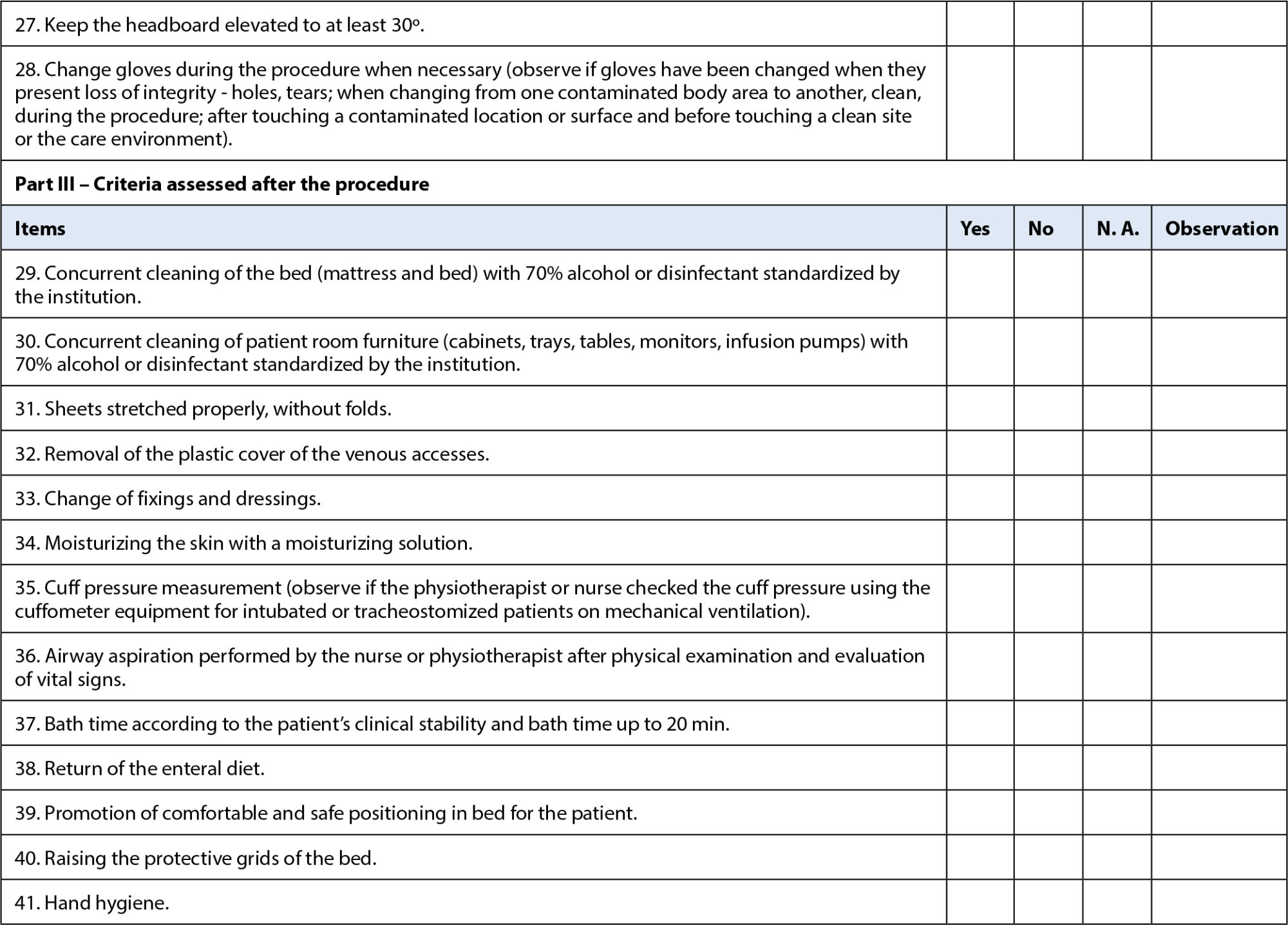
-
REVIEW11-29-2024
Assessment of knowledge in oncology about care for transgender people: a scoping review
Revista Brasileira de Enfermagem. 2024;77:e20230532
Abstract
REVIEWAssessment of knowledge in oncology about care for transgender people: a scoping review
Revista Brasileira de Enfermagem. 2024;77:e20230532
DOI 10.1590/0034-7167-2023-0532
Views0See moreABSTRACT
Objective:
to identify evidence available in the literature on instruments and methodologies used to assess healthcare professionals’ knowledge about cancer care for the transgender population.
Methods:
a scoping review was conducted in seven databases, including studies that answered the question: what is the healthcare professionals’ level of knowledge about cancer care for the transgender population?
Results:
forty-one articles were selected that dealt specifically with healthcare professionals’knowledge in relation to care for the LGBTQIAPN+ population, especially the transgender population. Eighteen studies assessed patients’ perceptions of professionals’knowledge, whereas other studies used their own assessment tools, considering the global context of LGBTQIAPN+ health.
Conclusions:
there is no tested and validated instrument that assesses the knowledge about the transgender population’s oncological health, highlighting the need to construct and validate an instrument focused on this population’s needs.
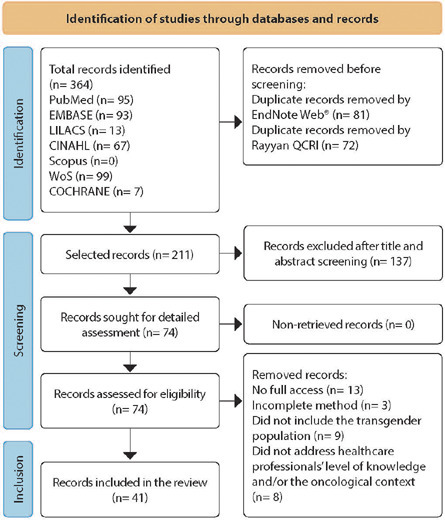
-
ORIGINAL ARTICLE11-29-2024
Sleep quality of vulnerable elderly people: associated factors
Revista Brasileira de Enfermagem. 2024;77:e20230283
Abstract
ORIGINAL ARTICLESleep quality of vulnerable elderly people: associated factors
Revista Brasileira de Enfermagem. 2024;77:e20230283
DOI 10.1590/0034-7167-2023-0283
Views0See moreABSTRACT
Objective:
To identify factors associated with poor sleep quality in elderly dependent individuals in social vulnerability.
Method:
Cross-sectional study with 59 elderly dependent individuals assisted by Family Health Units in São Carlos/SP. The following tools were used: Katz Index, Lawton and Brody Scale, Pittsburgh Sleep Quality Index, Addenbrooke’s Cognitive Examination Revised, Fried’s Frailty Phenotype, Geriatric Depression Scale (15 items), Perceived Stress Scale, Family APGAR, Social Support Scale from the Medical Outcomes Study, and World Health Organization Quality of Life, abbreviated and “old” versions.
Results:
The majority of participants were women (52.5%), aged 60-74 years (71.1%), and had poor sleep quality (76.2%). Stress (OR=1.12; 95%CI=1.02-1.22) and polypharmacy (OR=7.39; 95%CI=1.22-44.73) increased the chances of poor sleep quality, while physical activity decreased these chances (OR=0.15; 95%CI=0.02-0.79).
Conclusion:
Stress and polypharmacy are associated with poor sleep quality in elderly dependent individuals.
-
REVIEW11-22-2024
Transition to family parenting in the face of the first child: a scoping review
Revista Brasileira de Enfermagem. 2024;77(5):e20230487
Abstract
REVIEWTransition to family parenting in the face of the first child: a scoping review
Revista Brasileira de Enfermagem. 2024;77(5):e20230487
DOI 10.1590/0034-7167-2023-0487
Views1See moreABSTRACT
Objectives:
to identify and summarize the elements that characterize the family transition process in relation to the first child.
Methods:
a scoping review was carried out based on JBI methodology, in six databases, following the Preferred Reporting Items for Systematic reviews and Meta-Analyses extension for Scoping Reviews checklist.
Results:
ten articles were included with factors characterizing the transition, such as hindering/facilitating conditions that influence the process, important support structures in adaptation and strategies/responses used in the transition process.
Final Considerations:
elements characterizing the transition process in relation to the first child were identified. However, no theoretical explanation for this was identified. Further research should be carried out to obtain a deeper understanding of this process.
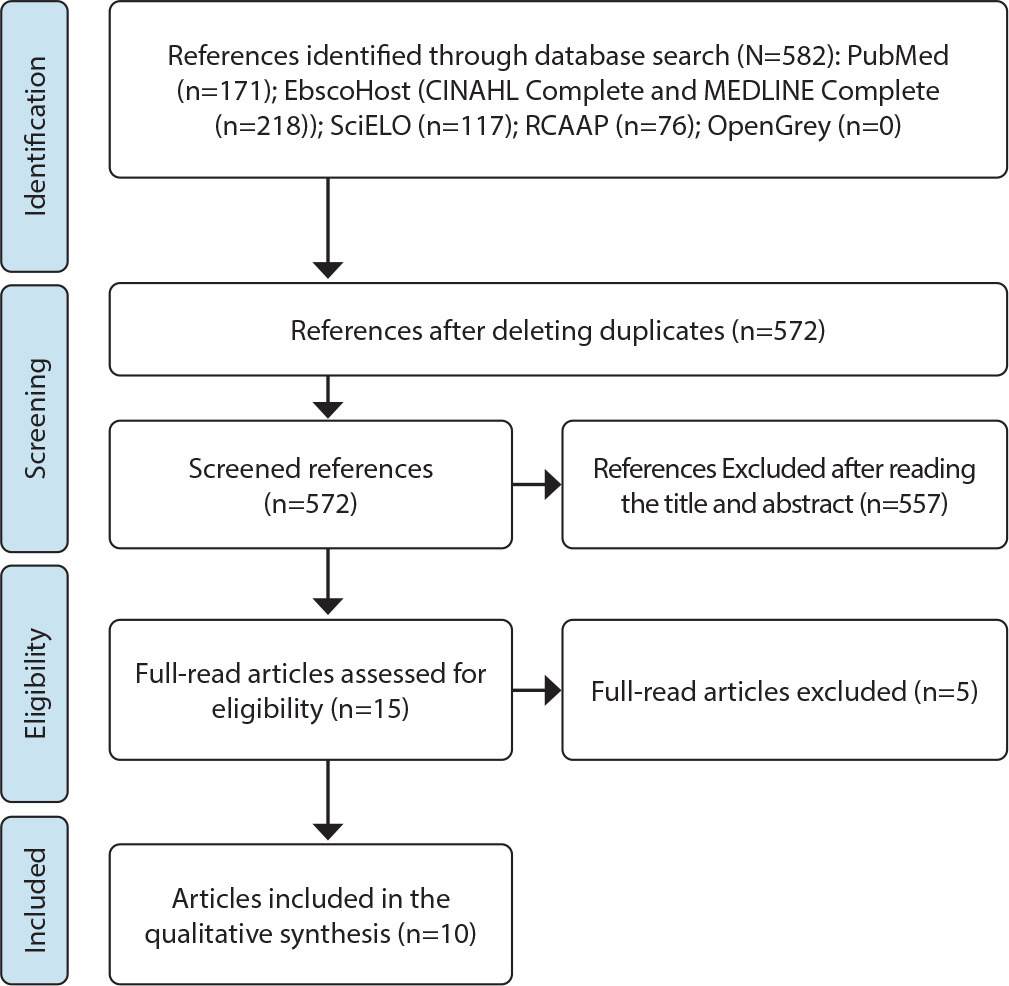
-
11-22-2024
Social Technology in the Prevention of Adolescent Violence: documentary production
Revista Brasileira de Enfermagem. 2024;77(5):e20230298
Abstract
Social Technology in the Prevention of Adolescent Violence: documentary production
Revista Brasileira de Enfermagem. 2024;77(5):e20230298
DOI 10.1590/0034-7167-2023-0298
Views0See moreABSTRACT
Objective:
To report the development of a technological innovation in the form of a documentary, aimed at disseminating actions for preventing violence against adolescents within the context of Primary Health Care.
Methods:
The documentary was developed through action research and interventions with adolescents in the territory of a Health Unit, conducted between 2020 and 2022, using Social Technology as both an action strategy and a conceptual reference.
Results:
The Social Technology proposal, created through workshops and seminars, resulted in a documentary focusing on violence prevention, involving 48 adolescents. The documentary’s script, collectively developed, portrays a soccer match between teams symbolizing peace and violence, with peace ultimately prevailing. The documentary is six minutes long.
Final Considerations:
The documentary has proven to be an effective Social Technology tool among adolescents, as it fosters critical thinking, is accessible, has potential for digital dissemination, and appeals to the target audience.
-
ORIGINAL ARTICLE11-22-2024
Prevalence of prescription and effectiveness of analgesia for treating vaginal delivery pain
Revista Brasileira de Enfermagem. 2024;77(5):e20230327
Abstract
ORIGINAL ARTICLEPrevalence of prescription and effectiveness of analgesia for treating vaginal delivery pain
Revista Brasileira de Enfermagem. 2024;77(5):e20230327
DOI 10.1590/0034-7167-2023-0327
Views0See moreABSTRACT
Objectives:
to assess pain management during labor.
Methods:
a cross-sectional study was carried out by reviewing medical records and conducting postpartum interviews. Prevalence and effectiveness of analgesia were assessed.
Results:
the prevalence of non-pharmacological analgesia was 61.86% of 215 women in labor in Obstetric Center and 82.51% of 62 in midwife-led unit. Prevalence of severe pain, on the Visual Analogue Scale, before and after non-pharmacological analgesia, was from 92.16% to 64.04% (p=0.00) in Obstetric Center and from 85.96% to 52.63% (p=0.01) in midwife-led unit. Prevalence of pharmacological analgesia in Obstetric Centers was 15.81%, with no variation in severe pain (p=0.57). Patients’ request for analgesia was associated with education (p=0.00) and pain intensity (p=0.02).
Conclusions:
non-pharmacological analgesia improved pain intensity. Prevalence of pharmacological analgesic prescription was lower than that identified in developed countries. Pain management needs to consider the preferences and needs of women in labor.
-
EXPERIENCE REPORT01-01-2018
Clinical and epidemiological teaching of dengue through simulated practice
Revista Brasileira de Enfermagem. 2018;71(2):451-456
Abstract
EXPERIENCE REPORTClinical and epidemiological teaching of dengue through simulated practice
Revista Brasileira de Enfermagem. 2018;71(2):451-456
DOI 10.1590/0034-7167-2016-0503
Views2See moreABSTRACT
Objective:
to describe the experience of clinical teaching on dengue and the practice of epidemiological surveillance using problematization methodology.
Method:
report of experience on educational activity with undergraduate nursing students, held in March 2016, at a public university in the city of São Paulo, conceived in four stages: dialogic lecture, active search of Aedes aegypti, case study and simulation of nursing consultation to individuals with dengue.
Results:
The activity allowed to retrieve previous knowledge about the disease, respond to exercises that addressed different clinical situations and epidemiological surveillance, including in situ evaluation of possible mosquito outbreaks, and discuss the need to expand prevention and health of the individual and the community, the impact of the media in the dissemination of cases and the coping difficulties experienced in the different levels of attention.
Conclusion:
the methodology adopted enabled qualified training of students to cope with dengue.

-
ORIGINAL ARTICLE07-18-2022
Beliefs, knowledge, actions of nursing techniques in breastfeeding in pain management in immunization
Revista Brasileira de Enfermagem. 2022;75(6):e20210546
Abstract
ORIGINAL ARTICLEBeliefs, knowledge, actions of nursing techniques in breastfeeding in pain management in immunization
Revista Brasileira de Enfermagem. 2022;75(6):e20210546
DOI 10.1590/0034-7167-2021-0546
Views1See moreABSTRACT
Objective:
Understand the beliefs, knowledge, and actions of nursing technicians on breastfeeding as a form of non-pharmacological intervention to relieve pain in newborns and infants during immunization.
Methods:
Qualitative study carried out through semi-structured interviews with nine nursing technicians from three Basic Health Units in a city in the state of São Paulo. The theoretical approach of the Belief Model and the methodological framework of Thematic Analysis supported this study.
Results:
Three themes originated: Beliefs, Knowledge, and Actions of nursing technicians.
Final considerations:
Despite knowledge about the benefits of breastfeeding as the most effective method for relieving pain in newborns and infants during vaccination, their restrictive beliefs overrode the evidence, leading them to act in ways that discourage or prevent the mother from breastfeed during vaccination. Formal training is recommended to align with current evidence-based practices.
-
REVIEW12-08-2023
Educational technologies for accident prevention due to falls in childhood: a scoping review
Revista Brasileira de Enfermagem. 2023;76:e20220807
Abstract
REVIEWEducational technologies for accident prevention due to falls in childhood: a scoping review
Revista Brasileira de Enfermagem. 2023;76:e20220807
DOI 10.1590/0034-7167-2022-0807
Views2See moreABSTRACT
Objectives:
to map evidence on educational technology use for accident prevention due to falls in childhood.
Methods:
a scoping review, carried out in October and November 2022, in the MEDLINE, Web of Science, BDENF and CINAHL databases and LILACS bibliographic index. There was no delimitation of language or time. Data were extracted and analyzed descriptively by two independent researchers. The research protocol was registered in the Open Science Framework.
Results:
twenty-six studies were selected. Booklets, pamphlets and leaflets were the most used technologies, presenting health services as the most frequent environment to develop research on fall prevention. The technologies developed were important outcomes: increased knowledge of children, family members, caregivers, health and education professionals.
Conclusions:
educational technology use makes it possible to increase knowledge, adopt safe practices and reduce falls.

-
REVIEW03-15-2024
Resources for health literacy among caregivers of prematurely born children: a scoping review
Revista Brasileira de Enfermagem. 2024;77(1):e20230062
Abstract
REVIEWResources for health literacy among caregivers of prematurely born children: a scoping review
Revista Brasileira de Enfermagem. 2024;77(1):e20230062
DOI 10.1590/0034-7167-2023-0062
Views1See moreABSTRACT
Objectives:
to map the available evidence on resources used to promote health literacy among caregivers of prematurely born children during outpatient follow-up.
Methods:
the Joanna Briggs Institute’s scope review protocol was utilized. The search encompassed six databases, incorporating studies from 2012 to 2022.
Results:
the three included publications revealed that the resources employed are: mobile applications, phone calls, individual counseling, videos, educational pamphlets, and group discussions. Implementing an education protocol during the transition home enhances scientifically grounded health promotion rates.
Conclusions:
there is limited literature addressing the health literacy of these caregivers. The nursing team plays a crucial role in health education and in developing resources applicable to these families.

-
ORIGINAL ARTICLE01-13-2024
Social representations of oncologic surgery for patients with cancer
Revista Brasileira de Enfermagem. 2024;77(6):e20230273
Abstract
ORIGINAL ARTICLESocial representations of oncologic surgery for patients with cancer
Revista Brasileira de Enfermagem. 2024;77(6):e20230273
DOI 10.1590/0034-7167-2023-0273
Views2See moreABSTRACT
Objectives:
to analyze the social representations of patients with cancer regarding oncologic surgery.
Methods:
a qualitative study based on Social Representation Theory was conducted with 126 participants between October 2021 and May 2022 in a public hospital in Rio de Janeiro. A characterization questionnaire, free evocations of the inducing term “surgery”, and semi-structured interviews with 60 participants were applied. Data were analyzed using Microsoft Excel® and IRaMuTeQ.
Results:
the central core of the representation is composed of fear, cure, hope, and removing the disease. The analysis of interviews resulted in six classes that highlight the social changes caused by treatment as well as the need for a support network to cope with the surgical process.
Final Considerations:
the representations reflect fear and hope towards the procedure and the desire to remove the disease, thus translating the cure through surgery.

-
ORIGINAL ARTICLE01-13-2024
Nurses’ perspectives on the use of telemonitoring in the management of people with diabetes and hypertension
Revista Brasileira de Enfermagem. 2024;77(6):e20230481
Abstract
ORIGINAL ARTICLENurses’ perspectives on the use of telemonitoring in the management of people with diabetes and hypertension
Revista Brasileira de Enfermagem. 2024;77(6):e20230481
DOI 10.1590/0034-7167-2023-0481
Views3See moreABSTRACT
Objectives:
to understand the perspective of nurses on the use of telemonitoring in the management of people with type 2 diabetes mellitus and arterial hypertension in primary care.
Methods:
this qualitative research involved sixteen nurses from eight municipalities in Paraná. Data were collected between November 2022 and January 2023 through inperson or remote interviews, which were audio-recorded and subjected to content analysis.
Results:
according to the nurses, telemonitoring enhances users’ knowledge about these conditions, communication and connection with the team, and productivity. However, the lack of electronic resources and equipment, high staff turnover, low user adherence, and the limited availability of professional time present significant challenges.
Final Considerations:
the effective implementation and operation of telemonitoring in the management of people with diabetes and hypertension involve both potential benefits and barriers. It is essential to have the availability of human and technological resources, managerial support, and the commitment of professionals and users.
-
ERRATUM01-13-2024
ERRATUM
Revista Brasileira de Enfermagem. 2024;77(6):e2024n6e08
Abstract
ERRATUMERRATUM
Revista Brasileira de Enfermagem. 2024;77(6):e2024n6e08
DOI 10.1590/0034-7167.20247706e08
Views2In the article “Brazilian nursing specific situation, middle and micro-range theories: a bibliometric study”, with DOI number: , published in Revista Brasileira de Enfermagem, 2024;77(4):e20230520, Chart 1:Where it read:[…]See more -
ORIGINAL ARTICLE09-29-2022
Palliative care production for health professionals in the context of home care
Revista Brasileira de Enfermagem. 2022;75(1):e20210030
Abstract
ORIGINAL ARTICLEPalliative care production for health professionals in the context of home care
Revista Brasileira de Enfermagem. 2022;75(1):e20210030
DOI 10.1590/0034-7167-2021-0030
Views1See moreABSTRACT
Objectives:
to analyze palliative care production developed by health professionals to home care patients.
Methods:
this is an exploratory study, with a qualitative approach, using the transpersonal care theoretical framework. Thirteen interviews were conducted with health professionals and 18 observations were conducted on different cases. Content analysis was performed using MAXQDA©.
Results:
actions performed: maintenance and follow-up measures to people eligible for palliative care, in acts of dialogue and “listening” to caregivers and users, conducting guidelines for the care and self-care process, performing technical procedures, delivery of materials, referrals and medical prescriptions to users.
Final Considerations:
it is perceived the need for advances in the implementation of government policies in Brazil that insert palliative care into the Health Care Network through educational, managerial and care actions that ensure human dignity, thus allowing the development of these and other palliative care interventions.
-
EXPERIENCE REPORT05-21-2021
Management of coping with the risks of COVID-19 in an onco-hematological outpatient clinic: an experience report
Revista Brasileira de Enfermagem. 2021;74:e20201080
Abstract
EXPERIENCE REPORTManagement of coping with the risks of COVID-19 in an onco-hematological outpatient clinic: an experience report
Revista Brasileira de Enfermagem. 2021;74:e20201080
DOI 10.1590/0034-7167-2020-1080
Views0See moreABSTRACT
Objective:
to describe the experience of a private outpatient network for hematology and oncology treatment in the adoption of management tools to face the risk of contamination by SARS-CoV-2.
Method:
an experience report on the use of a root cause analysis method to identify potential risks of contamination by COVID-19 among patients and employees. Through the risks identified through the Ishikawa Diagram, we built an action plan, linked to the 5W2H tool, for planning and decision-making implemented.
Results:
the number of attendances in person and people circulating in the units was reduced, protective distance measures and new protection barriers were fundamental to control the risks of spreading COVID-19 in patients and employees.
Final considerations:
the management tools served as a valuable tool in the construction of measures, making the measures in question more clearly and applicable.
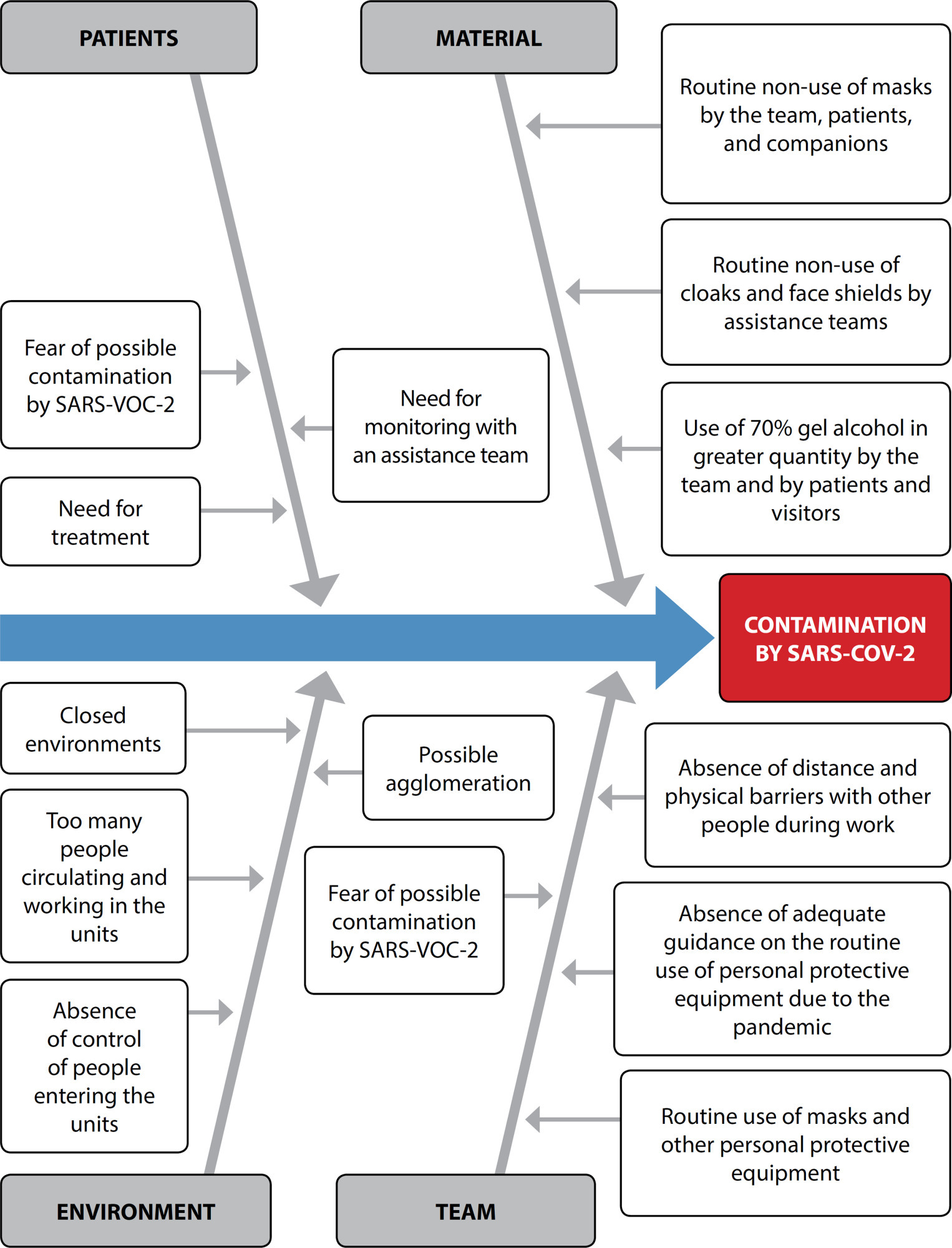
-
ORIGINAL ARTICLE09-06-2022
Evaluation of the health level of the elderly: patient care team considerations
Revista Brasileira de Enfermagem. 2022;75(1):e20201277
Abstract
ORIGINAL ARTICLEEvaluation of the health level of the elderly: patient care team considerations
Revista Brasileira de Enfermagem. 2022;75(1):e20201277
DOI 10.1590/0034-7167-2020-1277
Views0See moreABSTRACT
Objective:
To understand the differences of physicians, nurses, and social workers in the evaluation of the health status of the elderly.
Methods:
A cross-sectional quantitative study, using descriptive statistics. Non-probabilistic sample, consisting of 291 participants from three professional categories: 71 (24.4%) physicians, 192 (66%) nurses, and 28 (9.6%) social workers. We used a questionnaire including the variables: sociodemographic characteristics and instruments used for evaluation.
Results:
Instruments with greater utility for the evaluation of the elderly: for physicians, Mini Mental State Examination; for nurses, Braden scale; and for social workers, genogram. In the physical examination, the data most collected by physicians and nurses are the vital signs; and by social workers, the condition for performing the Activities of Daily Living.
Conclusions:
The evaluation of the elderly is based on a diversity of instruments and is an area in which health and social professionals need to share information.
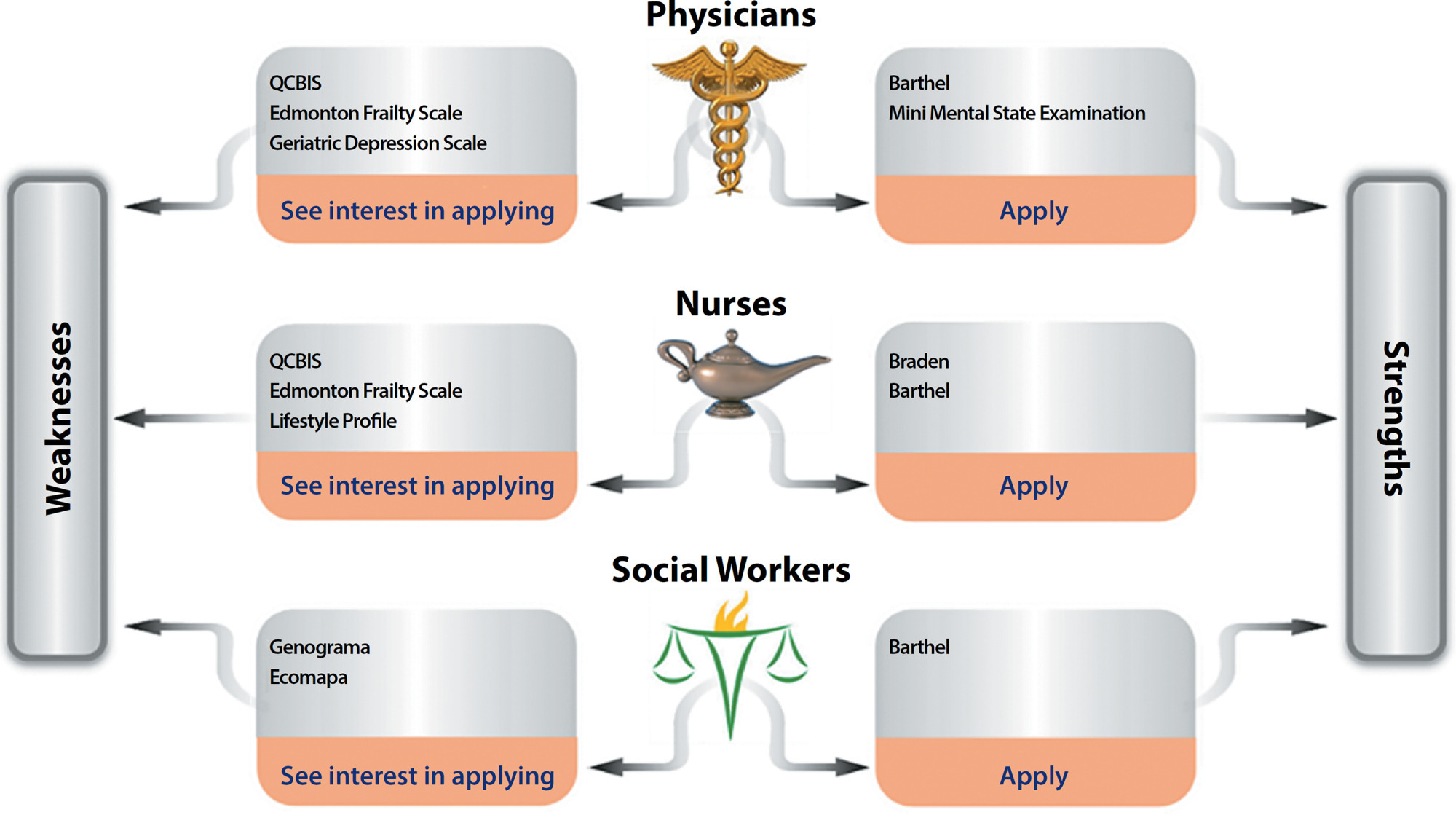
-
ORIGINAL ARTICLE09-24-2022
Patient safety in nursing technician training
Revista Brasileira de Enfermagem. 2022;75(1):e20201364
Abstract
ORIGINAL ARTICLEPatient safety in nursing technician training
Revista Brasileira de Enfermagem. 2022;75(1):e20201364
DOI 10.1590/0034-7167-2020-1364
Views0See moreABSTRACT
Objectives:
to analyze the contents on patient safety in the training of nursing technicians.
Methods:
a documentary study, conducted in three technical nursing courses at a public university in northeastern Brazil, based on the Multi-Professional Patient Safety Curriculum Guide, published by the World Health Organization.
Results:
we found that, of the 26 subjects in each course, the tracking terms were found in 22 subjects in the A/C courses, 23 in the B course. The topics of the guide with the highest number of terms were the improvement in medication safety, with 85 terms (22.6%), and Infection prevention and control, with 75 terms (20%). The contents do not express the comprehensiveness of patient safety education; some subjects had this focus, while others did not.
Conclusions:
the documents revealed gaps in the contents related to patient safety and demonstrated that they are addressed only in the course syllabus and discipline plans.
-
ORIGINAL ARTICLE03-24-2021
Content and usability validation of the Retire with Health web software
Revista Brasileira de Enfermagem. 2021;74(1):e20200133
Abstract
ORIGINAL ARTICLEContent and usability validation of the Retire with Health web software
Revista Brasileira de Enfermagem. 2021;74(1):e20200133
DOI 10.1590/0034-7167-2020-0133
Views0See moreABSTRACT
Objectives:
to validate the content and usability of the Retire with Health web software.
Methods:
a methodological study. The content validation was carried out by seven experts in the aging subject, using an instrument that evaluated the objectives, contents, relevance, and the environment of the web software. Usability was validated by seven experts in software development, referring to ergonomics, functionality, usability, and efficiency. The data were submitted to statistical analysis, described by calculating the Content Validity Index.
Results:
the global Content Validity Index found 0.97 for the usability aspects and 1.00 for the content. After incorporating all the experts’ suggestions, the Retire with Health web software was made available on the internet (www.aposentarsecomsaude.com.br).
Conclusions:
content validation and usability showed that the web software meets the objective of supporting reflection on retirement, with a high level of agreement among experts.
-
ORIGINAL ARTICLE09-29-2022
Construction and validation of an instrument for classifying nipple and areola complex lesions resulting from breastfeeding
Revista Brasileira de Enfermagem. 2022;75(1):e20210051
Abstract
ORIGINAL ARTICLEConstruction and validation of an instrument for classifying nipple and areola complex lesions resulting from breastfeeding
Revista Brasileira de Enfermagem. 2022;75(1):e20210051
DOI 10.1590/0034-7167-2021-0051
Views0See moreABSTRACT
Objectives:
to construct and validate a classification of nipple and areola complex lesions resulting from breastfeeding, according to content and appearance.
Methods:
this is a methodological study, developed in four stages: operational definition, instrument construction, content and appearance validation. The Delphi technique and a Likert-type scale were used to validate content and appearance, through the participation of ten and sixteen judges, respectively. For analysis, Content Validity Index and Kappa Coefficient were applied.
Results:
Content Validity Index obtained an overall value of 0.93 and, for appearance, 0.94. Kappa values ranged between 0.46 and 1. The high rates of agreement among judges demonstrated the quality of the proposed content validity.
Conclusions:
the Nipple and Areola Complex Lesions Classification Instrument developed obtained acceptable values of its indexes, proving to be valid in terms of content and appearance.
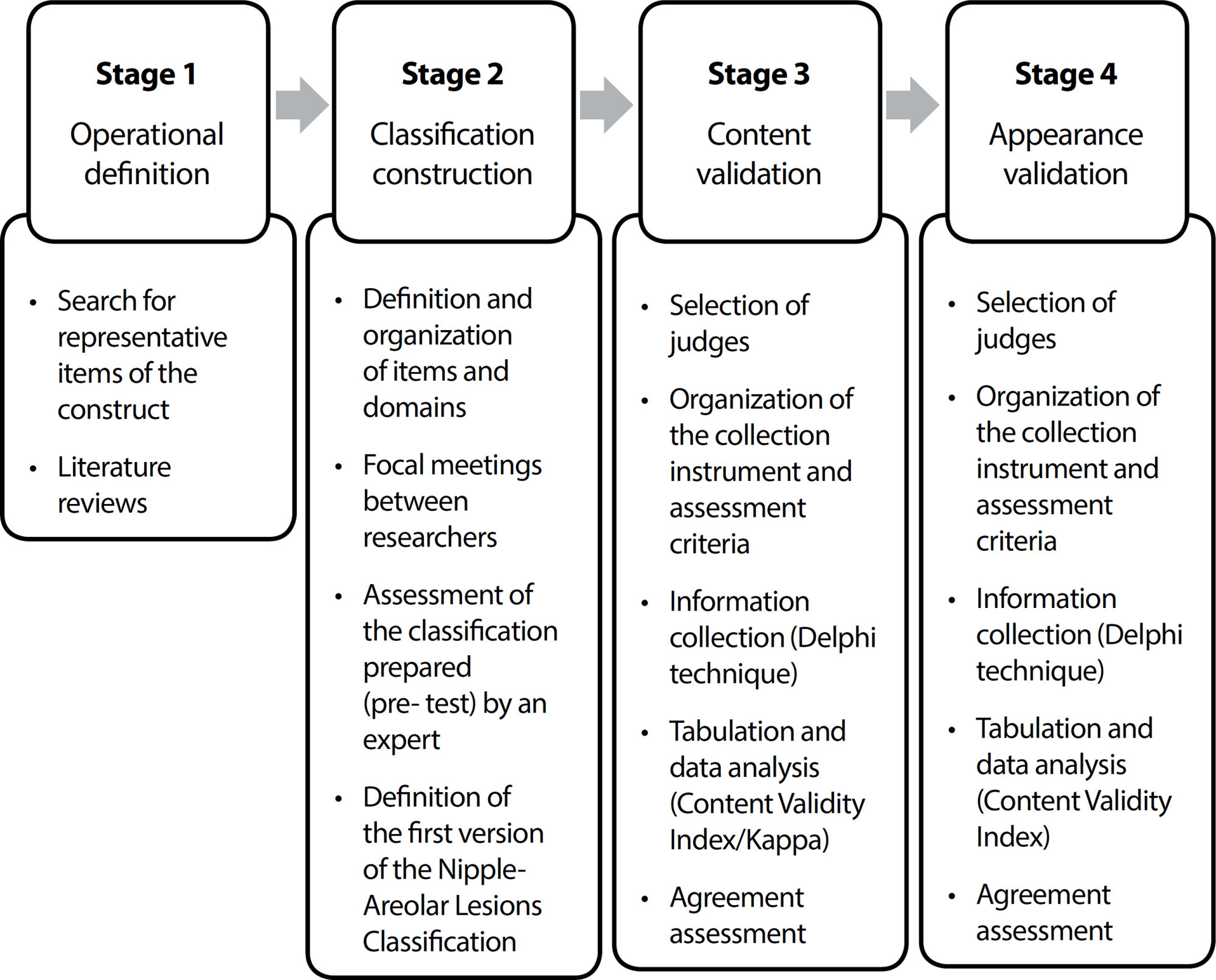
-
EXPERIENCE REPORT10-24-2022
Public policy for social inclusion in higher education and extension practices with ethnic groups
Revista Brasileira de Enfermagem. 2022;75:e20210970
Abstract
EXPERIENCE REPORTPublic policy for social inclusion in higher education and extension practices with ethnic groups
Revista Brasileira de Enfermagem. 2022;75:e20210970
DOI 10.1590/0034-7167-2021-0970
Views0See moreABSTRACT
Objectives:
to report the experience on the operationalization of a university extension project with and for training affirmative action students.
Methods:
an experience report with a descriptive approach on the operationalization of a university extension project for training affirmative action students, between 2020 and 2021, based on blended-learning and Activity Theory.
Results:
we carried out 103 activities, including actions for product development, media maintenance and targeted study of themes. They involved 13 students from two institutions, two leaders from ethnic groups and eight instructors.
Final Considerations:
collaborative relationships provided the exchange of knowledge about public health policies, educational technologies and social media, reducing deficits in the use of technological resources and application in health education. The activities promoted students’ leading role coming from affirmative action, in a representative way, from their experiences and needs, being potential for equitable training.
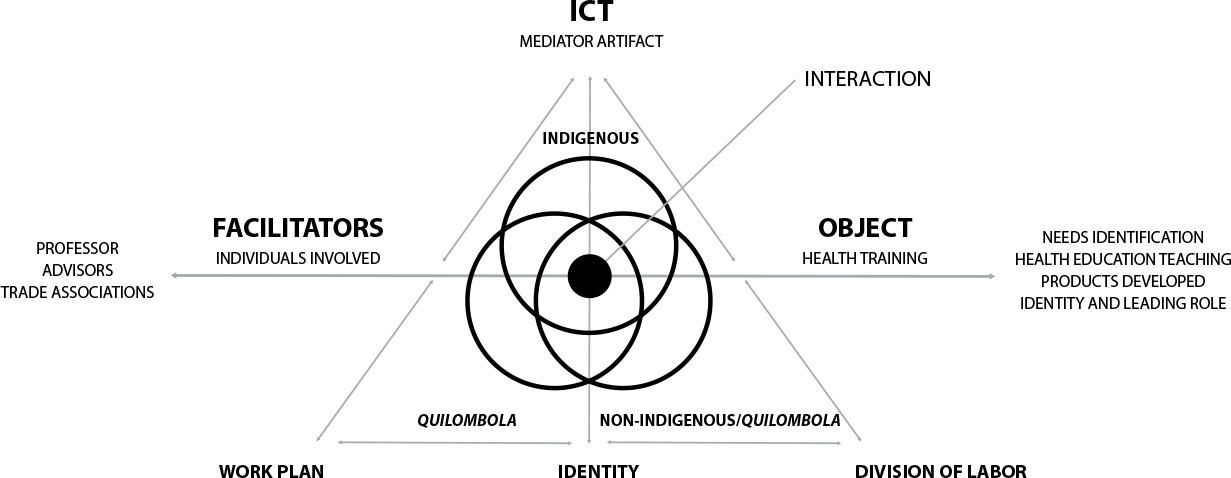
-
ORIGINAL ARTICLE07-23-2021
The role of grandparents of children with cancer in the hospital
Revista Brasileira de Enfermagem. 2021;74(5):e20201143
Abstract
ORIGINAL ARTICLEThe role of grandparents of children with cancer in the hospital
Revista Brasileira de Enfermagem. 2021;74(5):e20201143
DOI 10.1590/0034-7167-2020-1143
Views0See moreABSTRACT
Objective:
To understand the role of grandparents of hospitalized children with cancer.
Methods:
In a qualitative study, we interviewed eleven grandparents of children with cancer hospitalized at a referral center for pediatric oncology in São Paulo. The data were analyzed using the Hybrid Framework of Thematic Analysis.
Results:
Six themes were found to describe the role of grandparents in this context: Being the family’s support, Sharing love to my child and my grandchild, Being there for my child and my grandchild, Offering spiritual support to my child and my grandchild, Making an effort to be able to manage my own feelings and Balancing the demands of hospitalization with available resources.
Final considerations:
The findings show the significance of the grandparents’ role in this experience and emphasize the value of being considered, by health professionals, as part of the family and care.
-
ORIGINAL ARTICLE06-14-2021
Management of severe preeclampsia in the puerperium: development and scenario validation for clinical simulation
Revista Brasileira de Enfermagem. 2021;74(6):e20200445
Abstract
ORIGINAL ARTICLEManagement of severe preeclampsia in the puerperium: development and scenario validation for clinical simulation
Revista Brasileira de Enfermagem. 2021;74(6):e20200445
DOI 10.1590/0034-7167-2020-0445
Views0See moreABSTRACT
Objective:
to develop and validate a scenario for clinical simulation in nursing education on the management of severe preeclampsia in the puerperium.
Method:
methodological study in five stages (overview, scenario, scenario design progression, debriefing and assessment), developed from March to December 2019, involving 10 volunteers (one professor, five actors and four judges). Data were analyzed using descriptive statistics and Content Validation Index.
Results:
the scenario was built from the definition of learning objectives that meet the needs of nursing education. From the completion of a Likert scale, by the judges in on-site validation, a Content Validity Index of 1.0 was reached, which indicates 100% agreement in the assessed items.
Conclusion:
the scenario was validated. It is expected that teaching by simulation will be expanded and that new studies of scenario validation will contribute to the preparation of future nurses, based on the most recent scientific evidence.
Search
Search in:
Nuvem de Tags
Adolescente (85) Atenção Primária à Saúde (239) COVID-19 (91) Criança (91) Cuidados de Enfermagem (269) Educação em Enfermagem (151) Educação em Saúde (139) Enfermagem (930) Enfermagem Pediátrica (86) Estudantes de Enfermagem (77) Estudos de Validação (131) Família (87) Idoso (208) Promoção da Saúde (99) Qualidade de Vida (104) Saúde do Trabalhador (86) Saúde Mental (145) Saúde Pública (82) Segurança do Paciente (150) Tecnologia Educacional (100)




